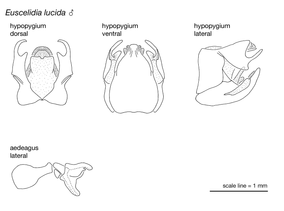You are here
Leptogastrinae
Euscelidia
Nomenclature
-
Subfamily: LeptogastrinaeTribe: Leptogastrini
SUMMARY
Head: face pruinose, facial gibbosity generally indistinct, sometimes distinct (lower facial margin protruding); mystax consisting of few macrosetae (4-12) arranged in 1 row or many macrosetae (usually more than 20) arranged in a number of rows dorsally on lower facial margin; ocellar tubercle apruinose or pruinose dorsally
Antennae: scape short; pedicel longer than scape; postpedicel cylindrical, generally longer than scape and pedicel combined, sometimes as short as scape and pedicel combined; style with two elements (narrow, cylindrical, long proximal segment and apical 'seta-like' sensory element), apical 'seta-like' sensory element hyaline or brown
Thorax: postpronotal peg small to large, pruinose; scutum entirely covered with pruinosity, median stripes and/or lateral spots apruinose, or predominantly apruinose (pruinosity restricted to anterior, lateral, and posterior margins), often setae scattered on surface; macrosetae: 1 notopeural seta, 1 supra-alar seta, and sometimes 1 post-alar seta; anepisternum and anepimeron covered with dense pruinosity, long, only seldom short, setae directing anteriorly on anepisternum and katepisternum, posterior half of katepisternum and entire katepimeron more sparsely pruinose; posterior scutum with short, erect setae; scutellum with short or long discal scutellar setae and scutellar setae
Legs: femora pale yellow proximally, with small, circular, dark brown spot apically, metathoracic femora distally clubbed; tibiae often with anterior pale yellow stripe not reaching tip; first tarsomere yellow proximally, brown distad, remaining tarsomere brown, black setae; claws black, long, pointed; empodium minute (indistinct), very short but distinct, or long (from a fifth to nearly the length of a claws), pointed
Wings: few microtrichiae or densely covered with microtrichiae, hyaline with or without microtrichiae (microtrichiae evenly scattered on remigium, but wings still hyaline) or opaque (wings brown coloured), veins generally brown, sometimes anterior veins pale yellow in proximal half or entirely pale yellow; pterostigma indistinct or distinct, light brown to brown; all marginal cells open, discal cell terminating in 2 or 3 veins, cell a2 generally broad, sometimes narrow; halteres yellow or brown
Abdomen: tergites generally entirely pruinose, but sometimes with apruinose spot proximally, sometimes female T8 apruinose, T1 generally with long setae laterally, T2 generally in proximal third to half with setae laterally, remaining tergites with short setae; sternites pruinose, S2 generally apruinose medially
Male terminalia: surstylus with either pointed distal tip or ending blunt, lobes dorsally and ventrally present or absent, sometimes distal tip sharply bent inwards; hypandrium enlarged, ventral margin straight or distally bent upwards and then with or without separated lobes (in posterior view); gonostyli small to large, often lateral process of gonostyli closely related to gonostyli present (not always determinable). Aedeagus: aedeagus generally only seen in dorsal view as a block between the aedeagal apodeme and dorsal aedeagal sheath; dorsal aedeagal sheath short, terminating blunt, or medium (not extending hypopygium) to long (extending hypopygium) and tubular, or forming an open extension without covering ductus ejaculatorius and extending beyond gonopore (sheath-like), lateral processes of dorsal aedeagal sheath sometimes present, short or long, extending gonopore; ventral aedeagal sheath generally composed of 2 sclerites, originating from dorsal aedeagal sheath, and fused dorsally, articulation with muscles laterally and on tip, sometimes expanded plate-like; lateral apodeme simple, cylindrical, proximally bifurcated, or triangular; aedeagal apodeme rounded, varying diameter
Female terminalia: unspecialised ovipositor; S9 with macrosetae distally; segment 9 generally hidden under T8.


